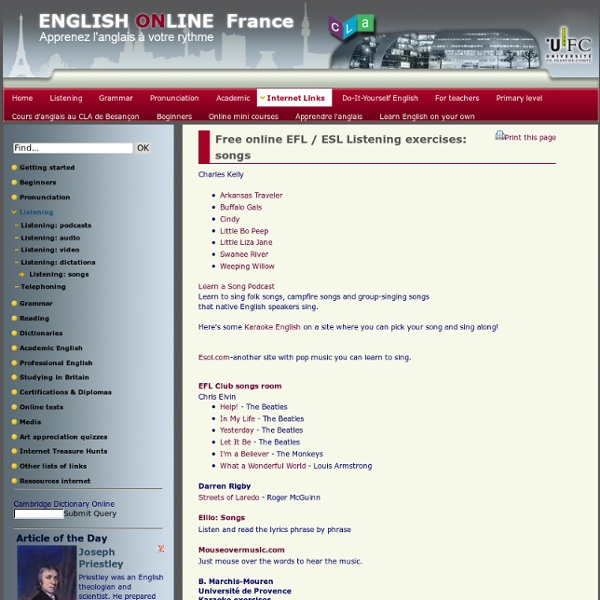



http://eolf.univ-fcomte.fr/index.php?page=learn-english-with-songs
Related: Good sites • listeningListening - Listening Exercises - Elementary Beginner to Elementary Inside-Out - Shopping Video Video TESOL Lesson Plans for Children - TESOL - Yahoo! News Search Results Teaching English to preschoolers (3 – 5 years old) Theme of the lesson: Learning things that are moving and related subjects to the moving things. Proficiency level: preschoolers (3 – 5 years old) ESL Lesson Plans and Resources on Music March is Music in our Schools Month! There has never been a better excuse to get up and dance with your students. To encourage you to bring music into your classroom throughout the year, we’ve created a collection of useful links. These links are full of ideas for using music in the classroom. You will find lesson plans, teacher reflections, books, webinars, website reviews, and more. Thank you to all of our teacher pals for suggesting links to add to this page.
10 Words to Cut From Your Writing As Mark Twain famously wrote, "I didn't have time to write a short letter, so I wrote a long one instead." His point? Strong writing is lean writing. When you want to make your writing more powerful, cut out words you don't need--such as the 10 included in this post: 1. Listening Comprehension: Story of the language course Use the story of our language course to develop and improve your English comprehension. The coherent story, which is divided into several chapters, guides you along the way. In addition to the text, each chapter offers pre-, while- and post-reading and/or -listening exercises. Reading and listening to the story, in connection with doing exercises, will be both fun and effective, no matter if you are a beginner of English or an advanced learner! Ad The story centres around the Fernandez family who starts a new life in England.
Teach Children ESL - Songs, Chants, and Action Rhymes FREE ESL Songs, Chants& Action Rhymes [To download the files, please click right-side mouse button on the "Download!" image and select "Save Target As..."] 1,197 ESL Songs For Teaching English Worksheets Music can be a great way to connect with your students. Even students who aren’t fluent in English often know the words of popular songs phonetically, which makes these songs ideal resources for teaching your students certain forms of grammar, as well as vocabulary. Many students are happy to work with the unusual phrasing of song lyrics, because they’re learning new meanings for a piece of music that already has meaning in their lives. You might never have noticed it before, but many songs’ lyrics involve just one single tense - which means that as soon as you find a song that contains the tense you want to teach, you’ve got the makings of an exercise that your students will love. They’ll get to brag to their non-English-speaking friends that they know exactly what the song’s lyrics say, so they’ll be extra-motivated to stick with you throughout the activity to make sure they learn those meanings correctly. But where should you start your search for the right song?
English Learning Online, ESL conversation, Speaking, Spoken English Expressions To teach and practice spoken English, we offer commonly used English Expressions for daily communication, ESL conversation & dialogues. We also provide pronunciation materials which help in the teaching and learning of a standard English pronunciation.We provide exercises to study or teach them, like mp3 audio downloads, printable worksheets and self-grading exercises. Communication- Daily Expressions EFL / ESOL / ESL Educational Songs and Activities: Song Lyrics for Teaching English as a Second Language These EFL/ESOL/ESL lyrics are available from a variety of albums: Songs that Teach Conversational English and English Vocabulary Action Songs Around the World – Jack Hartmann Can You Move Like Me? – Caroline and Danny Circle of Friends
How to use songs in the English language classroom What makes for a successful song-based lesson? Adam Simpson, second-time winner of the British Council’s Teaching English blog award for his post on conditionals (written with Paul Mains), explains. One of the big problems we all face, whether teaching English to children or adults, is maintaining learners’ interest throughout our lessons. Consequently, we often have to be very creative in the techniques we use. What makes music such a great teaching tool is its universal appeal, connecting all cultures and languages. This makes it one of the best and most motivating resources in the classroom, regardless of the age or background of the learner.
Animal Nicknames This works best with intermediate to advanced kids (not so much english for the advanced ones) Before class make up a sheet of paper with all of the students names on it with a blank line next to each name. Include your own name also. Hand these out to the students in class. Then tell them to look carefully at each of their other students. Tell them that their job is to think of what kind of animal that each of the students resemble and why.